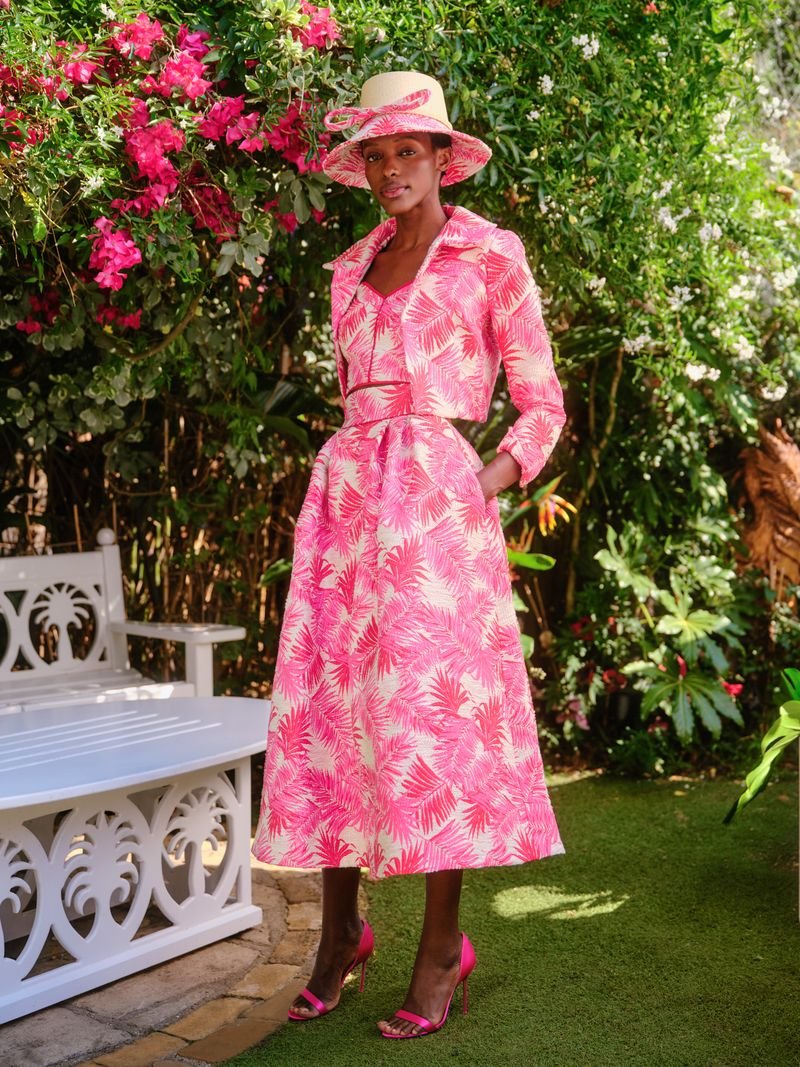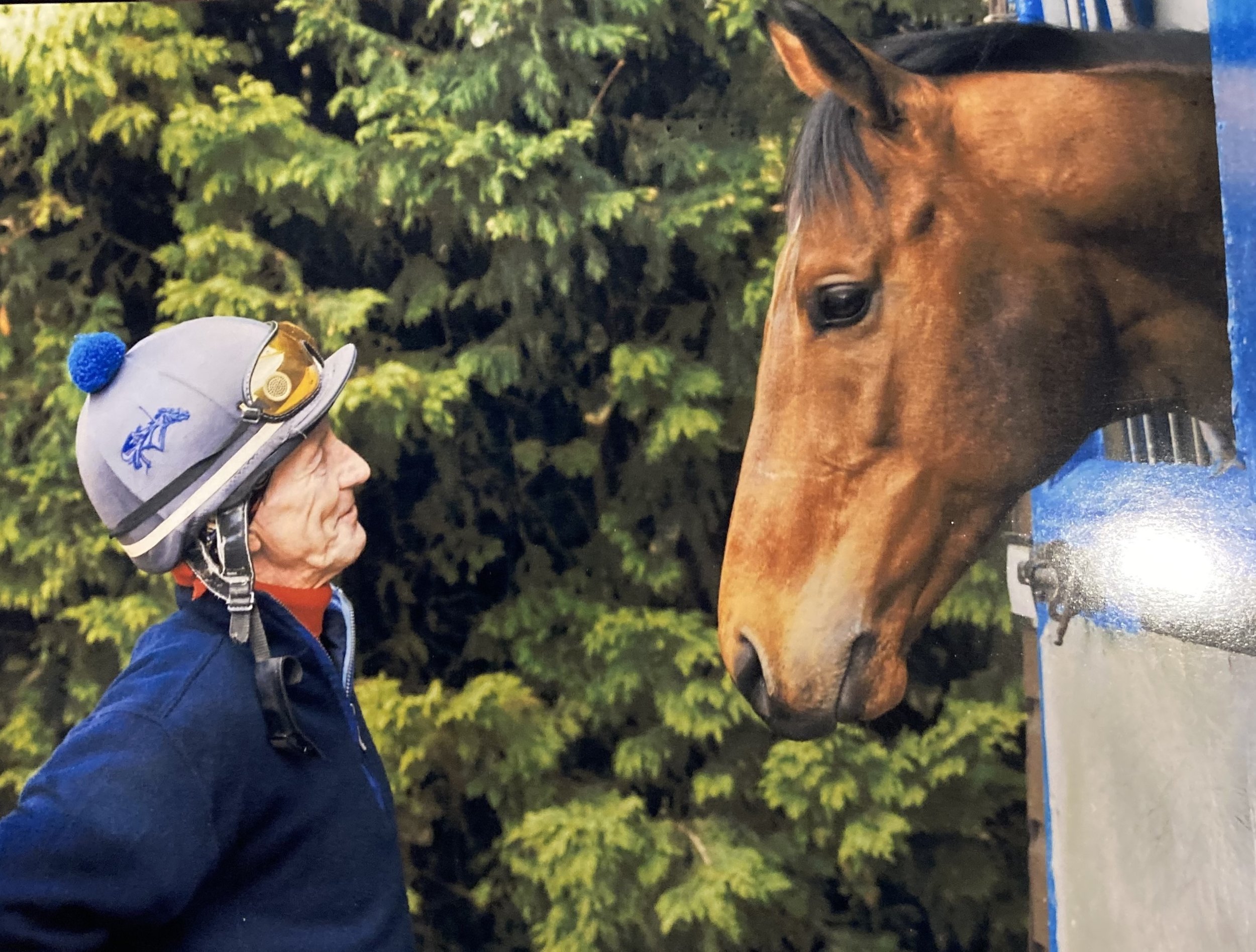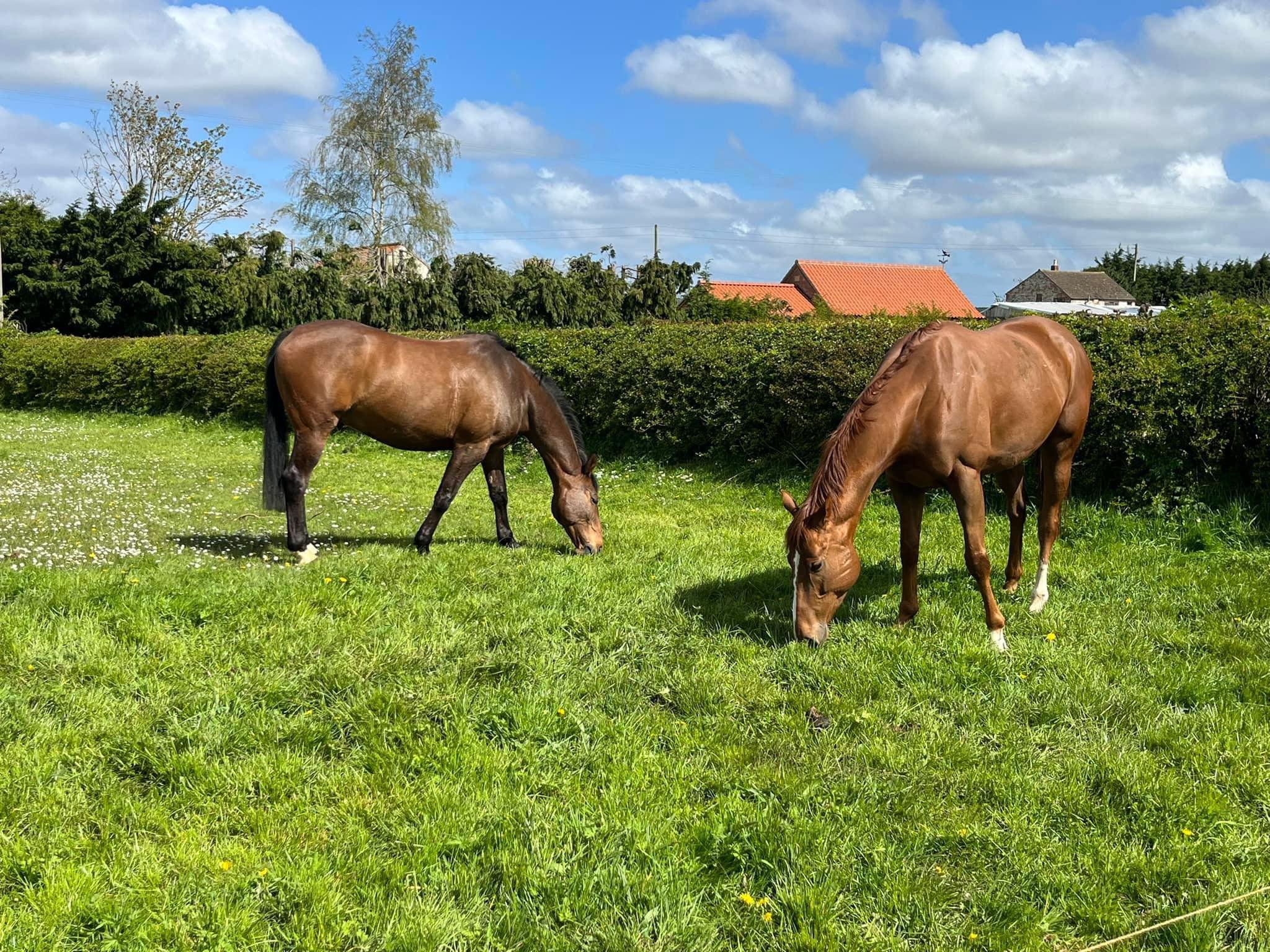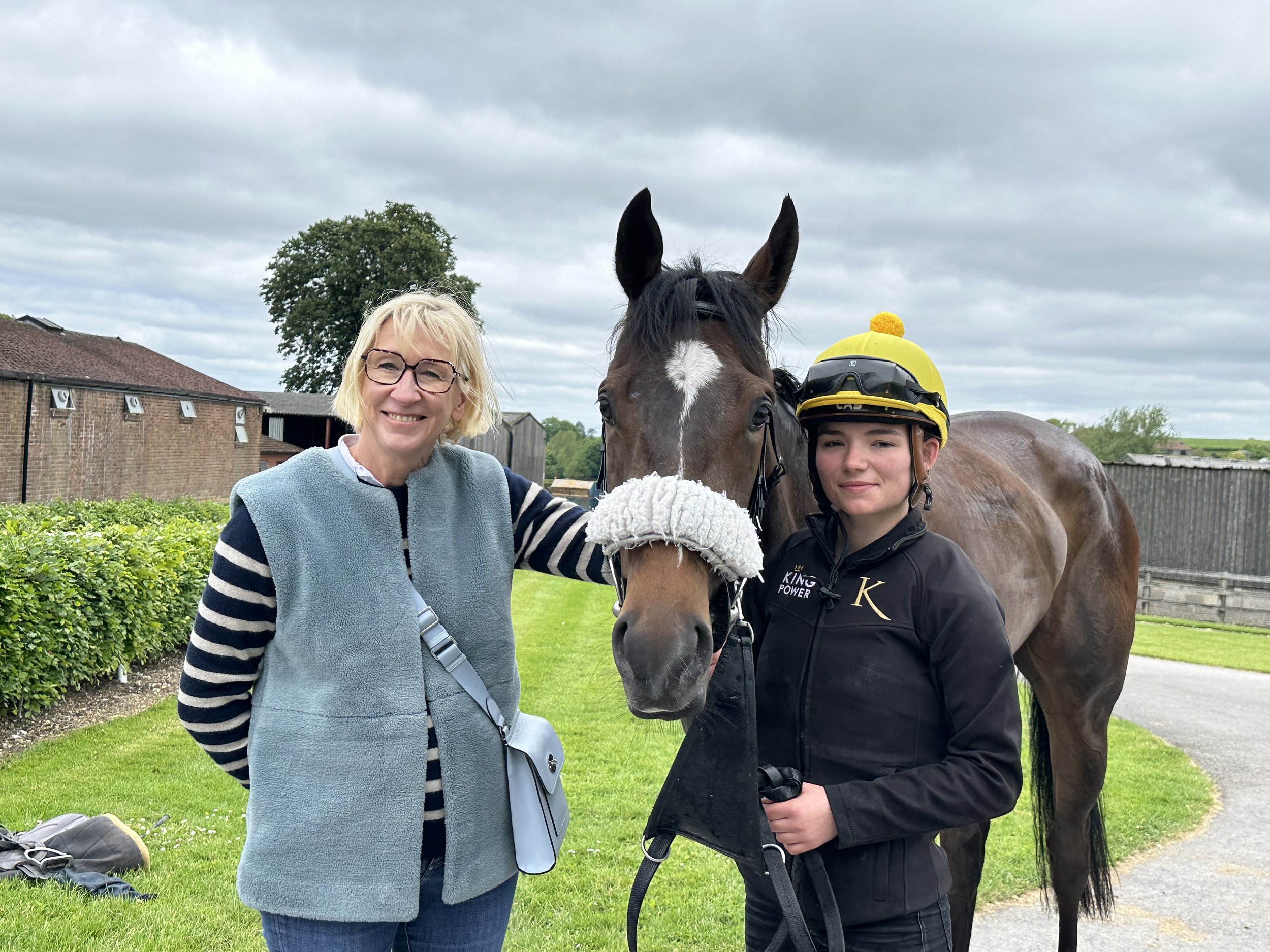May 2024
Bountiful winning at Thirsk in the Maiden Fillies' Stakes over 5f (18th May)
By Harry Herbert
I am so grateful to Robin Oakley for agreeing to write a piece for our newsletter this month. Robin was political editor to the BBC from 1992 - 2000 and from there he performed the same role for CNN as International Political Editor. Robin has also been a lifelong devotee of racing and I avidly read his pieces in the Spectator where he has been Racing Correspondent since 1994. His piece below is so good and I hope you enjoy it.
The horses continue to run well and we so nearly had a Group winner on Derby Day last weekend with Chic Colombine but bad luck in running sadly denied her victory. She might well go next to the Coronation Stakes (Gr 1) at Royal Ascot, ground allowing, as she must have easy ground to be seen to best effect. Our Royal Ascot team is beginning to take shape and we could have five or six runners but ground is always a key factor at this stage of the season and that might well knock a couple out whether too soft or too quick! As usual we will be having our picnics in the owners and trainers before racing on Tuesday through Friday and I hope very much that, if you are racing, that you will drop by to have a glass of champagne with a nibble or two.
The stable visits have gone on a pace and, as always, have produced great bonhomie at the dinners (if at the Jockey Club Rooms) along with the banter and excitement of seeing your horse progress physically as they move into faster exercise. Watching Rhetorical win so impressively on his debut at Newbury was the greatest thrill. His owners have been so patient - he didn’t run at two due to immaturity but this year as a much stronger three year old it was clear from his physical development and from his fast home work that we might have something a bit special to go to war with. Who knows how good he is but he certainly won like a good horse and William is considering the Hampton Court (Gr 3) at the Royal Meeting as his next race which has us all biting our nails!
The two year olds are coming on nicely and Bountiful’s win was a lovely step forward from her promising debut at Newmarket. She might head to the Albany Stakes (Gr 2) over 6f on the Friday of Royal Ascot if George is pleased with her home work.
Exciting times!!
With my best wishes,
Harry Herbert, Chairman
Horse in Focus
Pergola (IRE) (2YO b f Wootton Bassett x Il Palazzo)
Pergola (2yo b f)- at Newmarket February 2024
Please CLICK HERE to view a video of Pergola in Newmarket taken last week
I wanted to bring your attention to Pergola a beautiful daughter of Wootton Bassett in training with William Haggas. She is in our most exclusive syndicate the Kingfisher, with only 12 shares at a cost of £29,260 (plus VAT) per share. Do take a look at Emily’s video taken of her last week - she is an absolute stunner and as you will see she moves like a dream.
Her sire needs no introduction as he carries all before him with group winner after group winner and Pergola’s female family is fabulous too. This filly is much liked by William Haggas and it’s easy to see why - she has grown and filled to her frame since joining him and now looks as though she will be a July/August starter.
We paid 240,000 Guineas for her as we felt that she was without doubt one of the stand out fillies in the Tattersalls Book 2 sale.
We do have a share available in her so do take a close look as we think this filly is a bit special.
On the track
by Frances de Haan
This month excitingly saw in our first two-year-old winner with Bountiful flying the flag at Thirsk. After a promising start running at Newmarket back in April, she turned up the heat and got off the mark in style second time out on the 18th of May. It was a really smart performance by the Zoustar filly, who won cosily by just under a length from some potentially smart fillies making their racecourse debuts.
Bountiful broke well and, although seemingly jumping a path after a furlong, was going easily in front. She began to face a challenge at the 1f pole at which point Tommie asked her to go away from her rivals. She quickened away but he was able to ease down as they came to the line and they won with plenty in hand.
Bountiful justified favouritism and was also awarded the best turned out (and rightly so, she looked an absolute picture in the paddock). Bountiful would have learned a lot from that run, there was a big crowd at Thirsk with plenty of noise, so it was an excellent learning experience for her. Now with Royal Ascot and the 6f Albany around the corner, it is certainly not an opportunity to be ruled out yet!
In the three-year-old camp Rhetorical made a thrilling long awaited debut at Newbury landing the 2m 1f Maiden Stakes in no uncertain terms. He looked magnificent in the paddock; he really is such an imposing colt now he has strengthened up and filled to his frame. Before the race Tom Marquand stressed that today was all about giving Rhetorical a good education and anything else would be a bonus. But what a bonus!
Winning connections of Rhetorical at Newbury
Rhetorical broke reasonably well from the stalls, and he took a couple of furlongs before he got into a good rhythm, but he looked to really relax as they came toward the home bend. At this stage Rhetorical was sitting in behind a wall of horses, the pace began to quicken with about three furlongs to go and Tom asked him to go forward. He was somewhat green at first but as the penny began to drop started to make up ground. With horses coming back to him, Tom had to take drastic action, making a big move back towards the rail.
Having found daylight Tom then asked Rhetorical for another effort and he picked up in real style after a flick of the whip from his jockey. He flew past the front runners crossing the line with his ears pricked one and a half lengths in front of second placed Trouville. He is certainly an exciting colt with a bright future!
Rhetorical winning Newbury in the 2m 1f Maiden Stakes
Cuban Melody put in a smart performance at Windsor on the 13th of May to win in convincing style by a length and a half to second place Mono River. The filly had been knocking on the door of a win in her last two appearances with a second and then third earlier in the season, so she was well deserving of this victory. The 6f trip suited perfectly and she will stick at this distance for the time being.


Chic Colombine put in a storming performance at Epsom this weekend in a Group 3 mile and a half. After being very unlucky with both draw and ground out in France for the 1000 Guineas earlier in May, the going suited Chic much better this time round being on the soft side of good at Epsom on Saturday. In the race she broke well, and William Buick settled her towards the rear of the field. Unfortunately, upon reaching Tattenham corner the race did not quite unfold as planned, Buick had to navigate a rather severe traffic jam, breaking sharply and having to switch losing vital ground. However once unleashed she flew down the outside but couldn't quite make up the ground despite every effort, and she was denied by an agonisingly short neck. She would have passed the winner in the next few strides. After the race William was quick to blame himself saying he should have been more patient and waited to come around the field as he said she would have won with plenty in hand.
Chic Colombine and William Buick Epsom 1st June
It is clear that Chic Colombine is more than capable of competing at the highest level-particularly when conditions are in her favour. Chic is another filly that could well head to Royal Ascot should the ground be suitable!
On the National Hunt front we have had great success with the Dan Skelton trained Valgrand who has continued his winning ways. Valgrand justified favouritism in style making all in the 2m 3f 123y Novice Hurdle at Bangor to make it two on the bounce over hurdles.
The race went off at a fairly steady tempo, Harry Skelton had planned to stay tucked in behind main rival Speed Davis. However, as all great plans go, the field did not go out as strongly as hoped and so Harry adapted and made the decision to kick on in front. Taking up the running from the fifth he pushed on, adding the pressure on the now second placed Speed Davis. Arguably it became a two-horse race from this moment and Davis was always going to the horse to beat. However, two from home it was the turn of Valgrand to come under pressure, Speed Davis closed ranks and jostled Valgrand in the closing stages. Valgrand dug in and picked up convincingly, defending off the challenge with grit and determination to run on and hit the line in front, a convincing three and a quarter length victory.




It was a good education for Valgrand, who will have learned a lot from that race. Despite going out of his comfort zone out in front, he went round with his ears pricked and really showed his professionalism throughout. He now has a well earned six week break ahead of him before Dan brings him back in to prep for The Grade 2 Unibet Persian War Novices' Hurdle at Chepstow in October.
A successful month on the track and with Royal Ascot around the corner no doubt June will be one full of excitements too!
Racing politics
By Robin Oakley
Robin Oakley was formerly the Political Editor of The Times and then of the BBC. He was also European Political Editor for CNN. He has written a number of books on horseracing and for nearly thirty years has written the Turf Column in The Spectator
The American philosopher Lewis Mumford defined elections best. All the political parties, he declared, rush around the country insisting others are incapable of governing the nation—and in the end they are all proved right.
Opinion polls and bookmakers’ odds-setters can get it wrong. We had an excellent holiday once funded by the 50-1 Ladbrokes gave me against Margaret Thatcher becoming the next Conservative leader, a bet struck in 1974 because as a young political correspondent I was tuned into younger Tory MPs.. That said, since the Conservatives have accepted a reverse takeover by UKIP and turned themselves into a circular firing squad of irreconcilable sects it does seem unlikely that Sir Keir Starmer’s Labour Party could contrive to lose the election. Then if anybody wants to bet that a Labour Government is going to prove any better disposed towards recognising the needs of a racing industry seen as inextricably involved with gambling giants then I will happily accommodate them.
Racing seems to be on a loser whatever the political stripes of those who win the election. Readers of this newsletter know already from Rolf Johnson’s ruminations of the mess Tory administrations have made of gambling legislation with their backing for the ludicrous affordability checks and failure to achieve Levy reform. They do not understand or seem to care and despite the 200,000 racing industry jobs at stake there is no evidence of Labour having any more welcome thoughts. Racing and politics have moved off into separate and uncomprehending worlds.
Cecil Parkinson once told me of a day in Parliament with a key vote looming for the Thatcher government. He was invited by his Conservative Whips Office colleague Spencer Le Marchant for a pre-lunch drink in Annie’s Bar. After two Bloody Marys Spencer beckoned the waitress once more. “Steady on” said Cecil. “We can’t go on like this, it’s not even 11.30.” “ Quite right “ replied Spencer, turning to the waitress: “Two more, my dear, this time without the tomato juice”. It has stuck in my mind because the convivial Le Marchant was even then the last of his kind: since him there hasn’t been a proper racehorse owner on the Commons benches.
I never go to Windsor on a Monday night without recalling the time that Sir Spencer (as he became) persuaded a couple of us to join him in playing hookey from the Commons to go and see one of his horses run at the Thameside track. Spencer conveyed us from Westminster in a chauffeured Rolls with champagne and promised dinner at the Waterside Inn at Bray out of the expected winnings. Unfortunately the horse ran a stinker, he rowed with the jockey and we finished up eating cold pizza from a car boot in a Holiday Inn car park: a stark lesson that politicians can’t always bring off their promises. It is a measure of our times that while Rishi Sunak is one of the few MPs who could afford to buy a racehorse or two no image-maker would dream of letting him do-so.
It wasn’t always so. When the future Liberal Prime Minister Lord Rosebery was told by Oxford authorities that owning racehorses was inappropriate for undergraduates he wrote home “Dear Mother. I have left Oxford. I have secured a house in Berkeley Square and bought a horse to win the Derby. Your affectionate Archie”. In 1894 during his brief spell as Prime Minister, Lord Rosebery eventually did win the Derby and Ladas was cheered home as the shortest-priced winner of the race ever. Rosebery had a pretty good response to the politics of envy. When some churchmen complained that owning racehorses suggested a lack of seriousness about the day job he retorted that he had owned unsuccessful horses for many years without anyone complaining.
Winston Churchill, the last Prime Minister to own horses, bought his first at the age of 75 and with Walter Nightingall in Epsom as his trainer he won more than seventy races. Colonist II was his best known, not least because of Churchill’s comment when told that an injury necessitated him being retired to stud: “To stud? And have it said the Prime Minister of England is living on the immoral earnings of a horse!”
Under subsequent Prime Ministers some old traditions endured for a while. When he joined the Conservative Whips Office John Wakeham, a Minister under Margaret Thatcher and later a senior racing official was told that the standing instruction from Chief Whip Willie Whitelaw on the organisation of Parliamentary business was still “Light whipping for Royal Ascot week, no votes on Derby Day and get the House up for the summer recess in time for Glorious Goodwood.”
On the Labour side George Wigg, the sinister figure who was Harold Wilson’s internal spymaster, had shares in horses trained at Epsom by Ted Smyth and later became Chairman of the Levy Board. The onetime Tory MP for Montgomery Delwyn Williams told me once that he had been without a ‘pair’ in a tight Parliament—that is he had no deal with a Labour MP allowing the pair to miss votes together—and Michael Cocks, the Labour Chief Whip whose soup-strainer moustache had him described as ‘looking like a well-fed Mexican bandit’ called him in to say “I understand you receive occasional useful racecourse information. Also understand you have no ‘pair’. We could do business”. They did. Delwyn Williams got his Labour pair and Cocks received a tip or two. In Tony Blair days one-time Foreign Secretary Robin Cook was a genuine enthusiast who for a time wrote a racing column in the Glasgow Herald. It was, he said, a good exercise in humility for a politician.
Robin Oakley
Since those days though the differing social intake in the Commons and changing political mores have changed the atmosphere. A few MPs take a limited practical interest in racing because they have racecourses or training centres in their constituencies but with the perils of online gambling being constantly hammered home by newspaper leader writers few MPs see it as being good for their careers to be labelled friends of the racing and gambling worlds.
It all started with the way in which the 1960s Conservative Government in the 1960s legalised betting shops. The Government wanted to wipe out illegal backstreet bookmaking but also to grab the revenue to be had from taxing betting. To placate the moralists Rab Butler, the priggish Home Secretary, insisted betting shops should be seedy and miserable institutions. A punter leaving a betting shop, he declared, should be made to feel as shameful as a client leaving a brothel.
Styling with Suzannah
Suzannah London and the Many Facets of Royal Ascot
by Suzannah London
I launched Suzannah London 18 years ago, back in 2006, after graduating from fashion school and working for many years as a trend forecaster, as well as a womenswear designer specialising in dresses and tailoring. My work in the industry involved a lot of overseas trips, particularly visiting different Italian fabric mills, where I developed relationships with Italian manufacturers and gained a great deal of textile knowledge. I was lucky enough to travel all over the world, collecting fabrics and vintage finds along the way … American vintage couture became a bit of an obsession!
Entrepreneurialism was in my blood as my parents had their own business, and so, growing up, the desire to launch my own clothing line was always there. My first collection was very simple; ten beautiful, flattering and perfectly made dresses that were crafted to be investment pieces for every woman’s forever wardrobe.
Fast forward 18 years, and I’m here with a beautiful boutique on New Quebec Street in the heart of Marylebone, as well as an incredible atelier, just adjacent in Berkeley Mews. My incredibly talented fashion army of pattern cutters, dressmakers and everyone above and in between is based here, helping me to run a successful business which creates the most elegant ready to wear and couture dresses, as well as a beautiful womenswear collection, ranging from day-to-day luxury to formal occasion wear.
At the boutique, we also have an immaculate curation of hats, headpieces, and perfectly toned shoes and bags, allowing for a “one stop shop”, where our wonderful customers can create beautiful outfits for special occasions and life’s most memorable moments; all of which require appropriate attire which can sometimes seem daunting.
I began designing for special occasions very early on in the business, when one of my first commissions was to dress the Duchess of Gloucester’s daughters; Lady Rose Windsor, Lady Davina Lewis, and The Countess of Ulster; for the royal wedding of Princess Catherine and Prince William.
Since then, my brand, Suzannah London, has dressed some of the most remarkable women for incredible royal and high society moments, as well as fun, fabulous and joyous events. Our immaculately dressed clients have attended every event, dressed head to heel by us, from book signings to historic court cases, through to film festivals and notable BAFTA winning moments. Far from being boastful … since you’re only ever as good as your last commission … our team now has an incredible knowledge for what is appropriate and perfect for every occasion, how to style, and how to get it just right!
Head to hem looks, including millinery and shoes, have always been part of the experience when shopping at Suzannah London, since I started collaborating with British milliners very early on. In my opinion, millinery is the most brilliant way to personalise an outfit. Whether you’re wanting to look particularly refined, or make a subtle or outlandish statement, you can do whatever you desire with millinery. And that’s what is so much fun about dressing women for Royal Ascot … you must wear a hat! Or a very substantial head piece, certainly for the Royal Enclosure at least.
Royal Ascot dressing for us means quite a lot of things …
We are known for our outfits and looks at Royal Ascot, and wonderfully this year (and for several years now) our outfits have featured within their official ad campaigns, and in their signature style guides. Year on year, we also have the opportunity to dress the presenters, such as the wonderful Rosie Tapner and Francesca Cumani. We also regularly dress HRH Sophie, the Duchess of Edinburgh, for this occasion. These women are wonderful ambassadors for Royal Ascot, and so this always gives us great exposure.
Our clients can start planning their outfits for next year’s Royal Ascot from almost from the very moment that the first looks are shown in the media. We can start working on commissions as soon as the clients request them, but we find that a lot of women shop right up until the last minute, since they like to know the weather, and the feeling of this year’s event. This is such a popular option with our clients, since we offer off-the-rail ready to wear styles that are just perfect, with no last-minute alterations needed. Most women opt for dresses, and in particular this year, midi to ankle skimming dresses. Our modern, feminine skirt suits are also very popular, and whilst they’re slightly less popular this year, our trouser suits and jumpsuits have regularly been a huge hit.
We recommend booking a personal appointment with our wonderful sales team at our boutique to secure a fitting room, but we always have availability for walk-ins, if you prefer. The team will help to pull out the perfect outfit for your personality, budget, and body type. Since our range is so broad and varied to cover most styles and personal tastes, the opportunities for styling and personalisation are endless. The milliners that we work with offer customisation elements, which often includes colour matching, and we offer bespoke and alteration services, too. Whether you require a small tweak, or a full-on commission or made to measure piece, we’re always happy to help.
I always love to attend Royal Ascot. I love the racing, the celebration, and enjoying a special day out with close friends. I have some of the most wonderful clients, many of which are horse owners and trainers, as well as members of the Royal Ascot Racing Club, and so, getting the opportunity to socialise and network with my customers is always a delight (since they also gladly give me betting tips).
Talking of tips, here are my top styling tips for this year’s Royal Ascot.
Yellow is a big trend this year, in all tones from a pale lemon to sparkling gold
Head-to-toe ivory– a beautiful classic and timeless subtle statement
The pairing of green and pink is nature’s palette and also a beautiful trend for this year.
Making a statement with bold florals and stunning stripes is a fun way to play with colour at this joyous occasion.
When it comes to millinery, this year I have loved embracing a more classic hat, and moving away from the more modern substantial fascinator, and so I’m delighted to see a return to wider brims.
‘On the track’ with Chris StiCkles
What it takes to get the track ready for Royal Ascot
by Chris Stickles, Clerk of The Course Ascot
You could almost say that the preparation of the track for Royal Ascot begins at the end of the previous one as we aim to repair the worn raced-on surface as soon as we can to as high a standard as possible.
A key task in the summer though is the track renovation process, which we aim to carry out each year in August. This involves scarifying and then overseeding the whole Flat track. This is a very important turf management practice, particularly on sandy soils. The scarifying process removes thatch and shallow rooting weedy grasses such as annual meadow grass, both of which can become a problem if present in high volumes. Sandy soils require more fertiliser and water for the grass sward to thrive, which results in the production of more thatch and can provide an ideal environment for annual meadow grasses.
High volumes of thatch reduce the drainage efficiency of the racing surface and harbour pests and diseases. We aim not to use pesticides for environmental reasons, if at all possible, so this form of mechanical control is very important.
Meadow grasses have shallow roots and therefore require more food than ryegrasses they also are less tolerant to wear and more prone to being ripped out when raced upon; so are not ideal in the sward of a racing surface.
We only have a small window for renovations to be undertaken as we race in early September, so if weather conditions prevent this from being undertaken, either too wet or too hot can be problematic, then they would be delayed until September or even after QIPCO British Champions Day. One year, we were only able to carry this out in the winter, which was far from ideal when trying to establish new grass growth.
If all goes according to plan and the renovation process was successfully undertaken in August, then the preparation of the track for Royal Ascot begins in earnest when growing conditions start in the Spring. The track will have been aerated using a vertidrain machine and an earthquake/shockwave machine during the winter. This will have ensured that the surface is free draining and de-compacted so that root growth can establish as soon as soil temperatures allow.
Strong roots
We aim to have a healthy dense sward when our Flat season starts at the end of April, therefore the timing of our fertiliser applications are important. Grass roots start to grow when the soil temperature gets above 5C and grass shoots grow when the air temperature is consistently above 8C. On top of this, fertiliser and grass both need rainfall or irrigation and we don’t want to start watering unless it is necessary to affect Going conditions. So a close watch is taken on weather forecasts and we monitor the weather data recorded on our weather station; particularly the daily evapotranspiration.
The timing of most of our turf management practices is key to ensure that maximum benefit is gained from our actions. The goal is to have a racing surface that is free draining, consistent across and around the track, with a healthy dense sward, that is a mixture of Good and Good to Firm at the start of the meeting. The surface should then be able to withstand wear from nearly 600 runners and be a decent, fair and safe surface even in challenging weather conditions. In order to achieve this when soil and grass conditions are suitable and the weather is favourable the following practices are undertaken; normally in May and early June.

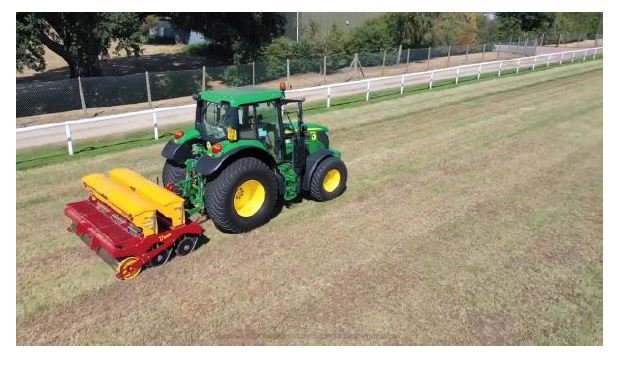

· Verti-draining; this is normally carried out twice with a 10 day gap between passes, this helps create a free draining surface that is ideal for root growth.
· Grass harrowing is carried out to prevent lateral growth, lift any decaying cuttings to the surface and to stimulate new growth.
· Fertilising; a number of different types of fertiliser are used depending on the weather and condition of the sward. We generally use a controlled release type of pellet that reacts to rainfall and temperature releasing nutrients when the plant requires them. We also use liquid forms of feed that are sprayed on and can have an immediate effect.
· A growth regulator is applied, sprayed on the track, this reduces the frequency that mowing is required and it thickens the sward at the base of the plant, helping it to become more wear tolerant.
· We use wetting agents that can be applied by a sprayer or through an irrigator. These are designed to aid the soil in both absorbing moisture and holding onto it, resulting in a more consistent surface that improves the efficiency of irrigation and helps even absorption of rain.
· The team make and apply compost tea; this is applied through a sprayer. It encourages microbial activity keeping the sward healthy and it helps reduce the occurrence of grass diseases.
In addition to the above activities, mowing is carried out normally every other day, the aim is to cut off small amounts so the cuttings, which are not collected, are left on the surface and can break down quickly. Ideally we mow when the grass is dry as results are better, wheeling’s on the track are less likely and disease risk is reduced.
We are constantly reviewing track conditions to determine if irrigation is required. Once a week during May and June we will take Goingstick readings and collect soil moisture data. This helps us decide on watering requirements and ensure consistency across the width and around the course. Watering is carried out using boom irrigators on the Straight course and pop-up sprinklers on the Round course.
As we get closer to the start of the meeting we collect and review Goingstick and soil moisture data more frequently whilst monitoring weather forecasts. We have a target range of data for both that we are aiming for the start of the meeting, which would deliver ideal Flat racing ground, and we react according to track and weather conditions.
If all has gone to plan by the time we are only a week from the start of Royal Ascot then only mowing and potentially watering of the track is required. Then of course when the racing starts so does the repair.
A flying start
By Annie O’Rourke
During my five weeks at Highclere Racing, I have had the pleasure of meeting a diverse array of people and witnessed elite thoroughbreds in action, both of which I am extremely grateful for. This exposure has prompted me to reflect on how and why I am choosing to pursue a career in horseracing as I look to graduate the Godolphin Flying Start program in June.
Leaning over the white railings of Keeneland racetrack in Kentucky, an Irishman likened horseracing to poker: buying a thoroughbred is your buy-in, and racing it is akin to hoping for a strong hand of cards. Though this analogy captures the essence of risk and reward, my experience at Highclere Racing has reinforced much more about the sport's appeal.
Growing up in Newmarket, the heart of British horseracing, my life has been intertwined with the sport from the beginning. My first home was in the stallion yard at Darley’s Dalham Hall Stud, at the time, home to legendary horses like Singspiel and Machiavellian. A magical place to grow up, this is in no small part to the hard work of my parents who met in the Darley offices, having both not come from a particularly long familial history in horses. Now retired, my mother was Stud Secretary, and my father is now the Director of Studs, Stallions, and Breeding.
Originally from the Isle of Wight, my mother moved to Newmarket when her teenage brothers decided to embark upon Jockey apprenticeships at the ages of 14 and 15 (Being vertically challenged runs in the family!). Plainly this was a bold move considering they had only learnt to ride the beach donkeys for pocket money. However, several trips to nearby Goodwood had them hooked on those thundering hooves and successful careers as jockeys, trainers, pre-trainers and head lads ensued.
My late uncle, Sean with his beloved Sixties icon. Winner of the 2006 St Leger Stakes
On my father's side, my grandfather was a large animal vet in Ireland who bred a mare or two in his spare time, until an encounter in the late seventies lead to an invitation to become Managing Director of Ballsbridge Bloodstock Sales that had just sold a 44% share to a British company, Tattersalls. Over several years, he would play a pivotal role in establishing the company and bringing veterinary expertise to industry trade standards. Fast-forward to 2024, and Tattersalls Ireland is one of the largest bloodstock sales companies in the emerald isle, with its National Hunt Derby Sale, celebrating 50 years this June.
Despite being so fortunate to be immersed in the sport, I took a brief detour, reading Psychology at Heriot-Watt University in Edinburgh. Although this was mean to be four years ‘away’ from the sport, my summers were still spent working in racing, from Lambourn to France, and Newmarket. Upon graduation, I completed the Irish National Stud Breeding course and from there applied for the Godolphin Flying Start programme.
So far I have described how I got into racing but I believe why, which is arguably more important to me, is more complex.
An immediate appeal to racing is the thrill of competition. Reaching speeds of over 40mph whilst negotiating twists, turns and obstacles creates a dramatic and entertaining contest that ultimately can produce any result. Just listening to the roar of the crowd at Royal Ascot or the Kentucky Derby showcases the power of competition and the captivation it can bring. This is a shared concept too in horseracing; at every stage of the animal’s life, there is a battalion of people caring for this athlete, hoping that one day they can witness its success alongside their friends and family.
The prospect of international travel is also enticing. As mentioned, my time on Flying Start has given me invaluable experience around the globe and, fortunately, a good horse can take you anywhere. To that effect, in recent weeks the Highclere Team are not long back from Hong Kong with Believing and Naval College ran a stormer in the Doomben Cup in the Gold Coast, Australia just last week……..
The appeal of competition and international travel is compelling, but I feel there is ultimately one, most significant aspect. In a recent newsletter, Emma Berry highlighted the industry's challenges: dwindling prize money, corporate dominance, and talent drain. Despite this, she urged readers to focus on the thoroughbred and the impact it can have.
Parading Invincible Spirit at the Irish National Stud
On The Flying Start, 11 others and I have been so fortunate to travel across five different countries and explore different racing jurisdictions. Whilst in America, I was lucky enough to spend five weeks at Belmont Park with Christophe Clement, including over the celebrated Belmont Stakes weekend. On this particular card, a horse named Cody’s Wish won the Metropolitan Handicap, Grade 1. Not only hugely talented and a multiple champion, but Cody’s Wish is also inextricably linked to the Make-A-Wish foundation when on a visit to Darley’s main American base Jonabell Farm. On the trip, a six-month-old weanling walked up to a young boy, Cody Dorman, and rested his head in his lap; Cody’s Wish was named. Over a three-year career, Cody’s Wish would win five Grade 1’s and two Breeders Cup races. Where possible, the Dorman family would travel to the racetrack to watch this equine marvel power through the American dirt. When in Belmont, I was lucky enough to witness Mr Dorman watching Cody’s Wish run. It is difficult to put into words the joy and emotion that this horse clearly gave this family, but all I can say is that moments like these illustrate why horseracing is not a game, far a poker match. It is not a win or a loss and cannot be measured objectively. It is about the profound impact of the horse.
Horseracing is a sport where passion meets purpose, and where every race tells a story of dedication, resilience, and hope. This, ultimately, is why I am drawn to it—it’s a world where the extraordinary becomes commonplace, and where every moment holds the promise of something unforgettable.
As I look to the future, I would like to take a moment to express my thanks for a wonderful five weeks at Highclere Racing. Everybody on the team as well as connections have been incredibly generous with their time, knowledge and kindness and I leave with fond and cherished memories. Best of luck with all your wonderful horses and I look forward to meeting you again in the future.
Thank you and goodbye to annie
We have been fortunate enough to have Annie O’Rourke join the Highclere ranks from the Godolphin Flying Start programme. If you have had the pleasure of meeting Annie I am sure you will echo our sentiments of how well she has thrown herself into life at Highclere, her knowledge and expertise have been a great addition and help this month.
Good luck in your future endeavours Annie, you will be missed!
Don’t overlook Burgundy’s neighbour
By Alex Smith
I am always looking for something different in the red stakes as the weather warms up and more often than not I turn to Beaujolais, sometimes referred as Burgundy’s poor cousin.
Far from it, Beaujolais has a rich history and produces some excellent wines which are perfect for warmer times particularly as the wine can benefit from chilling!
The region was first cultivated by the Romans who planted vines along the Saone valley. The most notable vineyard was located on the slopes of Mont Brouilly, but they also planted around Morgon. Benedictine monks took up the mantle from the 7th century to the middle ages. The wines from Beaujolais were mostly confined to the markets along the Rhone and Saone, particularly in the town of Lyon. As railways expanded, so did the reach of these wines, extending up to the lucrative Paris market.
Slightly disappointingly, Beaujolais was at it’s most popular with the advent of Beaujolais Nouveau. Many of us will remember the Beaujolais Nouveau breakfast which became hugely popular in the city, with merchants like myself filling the boot of their car with a wine that had arrived very early that morning, having only been in the bottle six weeks after the harvest! This light, purple wine was the equivalent of a juicy fruit and needed a decent breakfast to make it palatable! With the advent of Perrier water and boozy lunches on the wane, Nouveau began to fall out of fashion, in part also to the reality that it tasted more like fruit juice than wine!
Beaujolias proper produces some serious wines, which while may not be long term keepers can give real short to medium term pleasure and cost a fraction of the absurd prices now being charged for Red Burgundy.
Sandwiched between Burgundy and The Rhone, the Gamay being the dominant grape for reds and Chardonnay for whites. Of the 18,500 hectares (half of total worldwide gamay vineyards), only 200 of which are given over to Chardonnay, the wines either named Beaujolais Blanc or Beaujolais-Villages blanc. Gamay needs at least a short spell of real heat in order to ripen properly which it usually gets. Yields can be huge despite the vines growing on granite and schist soils.
While there are some 2600 growers, not so many of them own the land, most being tenants and pay their landlords either in cash or wine! Making a living in Beaujolais isn’t easy, as the cost of producimg the wine is high and selling prices are relatively low. Historically negociants were strong but are gradually reducing. Recently there have been positive developments with investment from Burgundian houses such as Bouchard and Louis Jadot (who’s Moulin a Vent is one of the most recognisable of all Beaujolais).
Beaujolais wines are produced by the wine making technique of semi-carbonic maceration. Whole grape clusters are put in cement or stainless steel tanks with capacities of between 4,000-3,000 litres. The bottom third of the grapes gets crushed under the weight of gravity and resulting must begins normal fermentation, releasing lots of colour and attractive fruity flavours without tannin. For the finer wines, winemaking is more traditional; crushing, them maceration.
Around 40 million bottles of basic Beaujolais are produced every year, with same amount of Beaujolais Villages. I would bypass the basic wine, but good Beaujolais Villages often represent really good value for money. The key as in many areas of the wine world, is to avoid the mass produced wines and focus on producers with passion and a more handcrafted approach to wine making.
Around 40 million bottles of basic Beaujolais are produced every year, with same amount of Beaujolais Villages. I would bypass the basic wine, but good Beaujolais Villages often represent really good value for money. The key as in many areas of the wine world, is to avoid the mass produced wines and focus on producers with passion and a more handcrafted approach to wine making.
So to the wines:
The best known is Fleurie, where pink granite soils produce perfumed wines with bright vibrant fruit, ideal for summer lunches and barbeques. And as mentioned can be chilled! The largest cru in the region is Brouilly which tends to produce easy drinking, uncomplicated wines, although with such a large district, there is some variation. Of the more full bodied styles, Morgon, Moulin a Vent , Chenas are all capable of producing really good wines which will benefit form some aging (the best four to five years). The delightfully named Saint Amour are often generously flavoured, sometimes a touch rustic and need some time. Julienas is also one of the largest areas, often plagued by hail storms and these wines tend to be ready earlier.
As it happens I was browsing the website of one of the very best wine merchants in the country, Lea & Sandeman, who by complete coincidence are running a brilliant offer for some of the best wines of Beaujolais! The offer consists of a mixed case (2 bottles of each of six wines), which is a great way of trying the wines! Delivery is free. Please click here to see the offer. Browse our latest Wine Offers online | Lea & Sandeman (leaandsandeman.co.uk)
Rolf’s Ramblings
by Rolf Johnson
Anything I can do, I can do better
Anything I can do, I can do better – well not quite the lyrics of the original soundtrack of Annie Get Your Gun but Aidan O’Brien who has just trained his tenth Derby winner, would subscribe to the sentiment - if not the hubris. A modest man he said: “You always try to learn from your mistakes,” welcoming City of Troy back to the Epsom circle.
His ‘mistake’ had been to neglect “all stones being unturned” in his preparation of City of Troy for the Two Thousand Guineas where the colt’s performance was as abject as his Coolmore stable companion Auguste Rodin’s in the same Classic last year. Auguste Rodin went off 9-2 in his redemption Derby: City of Troy was 3-1. They’d both been at virtually unbackable short odds before failing to do what the market said they would do in their respective Guineas.
Can O’Brien do better than last Saturday? The best bet of this season is that at some stage, when a Coolmore juvenile has won its third Group One in a row, he (or she) will attract the same superlatives, “unusual” “special” “remarkable”. The rash “Our Frankel” eulogy (not attributable to the trainer) that came from the City of Troy camp was the albatross hung round the colt’s neck after his stellar juvenile year.
The ‘stones’ O’Brien admits to having left unturned in City of Troy’s Newmarket preparation must have overlaid deeply buried gems of understanding because almost alone he went through the age old saddling process in the exposure of Epsom’s parade ring. That put the horse into the right frame of mind. Ryan Moore was already ‘in the zone’.
The last touches of genius to City of Troy’s precise preparation were like Van Gogh’s masterpiece “Wheat field with crows” with its primitive, daubed, black birds, circling an azure sky, a seemingly mundane afterthought. Nothing of the sort; O’Brien’s final touches were another reminder of his genius. After saddling, instead of giving the colt a slap on the backside and sending him on his way, the trainer applied his dandy brush to City of Troy’s gleaming off hind quarter while invaluable aide Pat Keating held the colt’s nearside foreleg. The procedure was repeated nearside, Keating holding the off-fore. A brush of the light-coloured tail then the trainer took over, stretching his horse’s forelegs in turn to avoid any crimping and pinching under the girths. In past times, when staff numbers matched horse numbers, you saw such actions all the time.
When Ryan Moore was legged up on the drifting favourite the horse was in the same concentrated frame of mind as his rider. That’s not rank anthropomorphism. At Newmarket O’Brien, post-race, concluded his horse’s heart had over-raced. Difficult to tell whether or not the trainer tightened his own ‘girths’ and what his heart rate registered at Epsom though it must have calmed a notch or two as City of Troy and his jockey, as one, rolled to the start.
Coming back, from the number one draw (when will they stop calling the stall the ‘coffin box’ which Oath, Adayar and now City of Troy have found no difficulty “overcoming”?) there was never a moment when horse and jockey didn’t appear in control – the kind Lester Piggott would exude. You couldn’t have imagined a Derby without Lester. And yet there was no mention this year of an absentee still riding Derby winners. Across the pond Frankie Dettori was doing just that, in the Jersey Derby.
Will City of Troy follow where Auguste Rodin trod? Auguste Rodin, among lesser triumphs than the Derby (I choose my words hesitantly there) has subsequently both won and finished last, twice, in the King George and in Meydan. Some cavilled about City of Troy’s quite lean appearance – which is as nature, certainly not ‘experts’, intended! So what of his future? Well, when he goes to stud as the first son of Justify, unbeaten American Triple Crown winner, to stand in Europe, ‘Our Frankel’ will get the best of mares. But it will still be a case of mate the best with the best and hope for the best? Can he do better than, or come anywhere near his Coolmore predecessor, Galileo?
Recent fashion has scoffed at the world’s greatest breeder Federico Tesio’s oft repeated, “The thoroughbred exists because its selection depended not on experts, technicians or zoologists but on a piece of wood: the winning post of the Epsom Derby.” There are similar white winning posts with red circles the world over but Coolmore sets its sights on the one in Surrey. They can afford, now, to jest about Saturday’s ‘defeat’ by Richard Hannon’s Voyage, first past the post but unfortunately without his jockey Pat Dobbs. One horse’s achievements even O’Brien couldn’t match is Cadland’s who won two Epsom Derbies. He first dead-heated with The Colonel but beat him in the re-run. 1828 was a long time ago.
2024 was my 50th Derby (out of 245) and like the first I was on The Hill – which was spelled out in wooden letters in case you didn’t know where you were – though you’d hardly confuse it with HOLLYWOOD. There was nothing displayed on the tattiest of tat stalls that cost more than £10 – not even a plate of chips – the cost of my parking. If the aim had been to give the free enclosure greater cachet I’m sorry to say any hoped for green shoots of recovery in Epsom’s attendance shouldn’t be confused with the wide patches of unoccupied sward. The “millions” that Dickens imagined he saw was poetic licence. Last Saturday you could knock a nought off the 270,000 that attended the Derby post-war.
Timeform denigrated the Derby day of 1979, the 200th, Troy’s year. They quoted a Victorian description: “Epsom Downs on the Derby Day is the most astonishing, the most varied, the most picturesque and the most glorious spectacle that ever was, as ever can be, under any circumstances, visible to mortal eyes…For once, people speak to other people to whom they have never been formally introduced and positively hob and nob with those palpably inferior to them in status. It is clearly subversive of the proper distinctions which should always in a well-governed society exist between class and class.”
In 2024 there were far more helicopters parked on top of The Hill than open-topped buses at the bottom. And there was little or no bond between my fellow Hill watchers and happenings on the course. The Berlin Wall was never more securely patrolled than Epsom’s enclosures (no Checkpoint Charlie to cross over to ‘the other side’). The commentator’s voice which prompted a desultory cheer before the first, was unintelligible when competing with the Hill’s ear-splitting funfair. And the singing of the National Anthem, done with some gusto by my neighbours was, overall, lost, blowing in the blustery wind.
I saw not a single copy of the Racing Post (£5 ten pence); nor binoculars; the Tote World Pool shacks were as mysterious to once a year racegoers as the pronouncements of Gypsy Rose Lee once were. I saw only one hot gospeller ensconced in his gazebo eating ice creams rather saving souls. There used to be competition for racegoers souls, or at least their money, with pickpockets, three-card merchants and thimbleriggers lining the route. Dickens’ character Little Nell in The Old Curiosity Shop says, “How strange it was that horses such fine honest creatures should seem to make vagabonds of all the men they draw about them”.
The vagabonds have gone. It was obvious where the playing card, the Queen, as in ‘Find the Lady’ was located, or which cup held the dice, but accomplices would lump on the wrong ones and the gullible would follow them in. Back in 1974 I calculated that my insignificant half-crown on the correct card would be accepted – make everything look more authentic, wouldn’t it? On a cloudless day a shadow blotted out the sun, not an eclipse, but a gorilla leaning over my shoulder. The ‘minder’ growled “Beat it sonny”. I had the presence of mind to grab my half-crown before skedaddling.
In the mid nineteenth century Dickens, a regular attendee, also wrote: “Look where I will…I see Fortnum & Mason hampers fly wide open, and the green Downs burst into a blossom of lobster salad”.
I saw nary a Fortnum & Mason hamper this year; burger vans aplenty, yes. progress?
You always remember your first - Derby winner. It isn’t just a horserace it used to be an annual ritual, even a pilgrimage. Who was Prime Minister, or even who won the Eurovision Song Contest (except perhaps if it was ABBA), or who won the FA Cup, mattered less (except if it was your team though mine’s success in 1912 is a fading memory).
Little did I or anyone else know before Morston’s Derby that arguably the last gentleman trainer – trilby and tweeds – Arthur Budgett, had told his jockey Edward Hide not to be too hard on his inexperienced, under-prepared home-bred mount. Disgustedly, Hide told the jockey on the next peg in the Epsom weighing room that he, the Cock o’ the North, had come all the way from Yorkshire where he’d had a full book of good things at Ripon, to ride a no-hoper. He won at 28-1.
Next year was my year. You could have had 66-1 near the off about Snow Knight. I’d seen him finishing well in the Lingfield Trial. I’d tipped him in in our university newspaper and for a short while had the freedom of the campus – Vice Chancellor, Rag Queen, I could take my pick. If I’d known that four short years later I would be working with Snow Knight’s jockey Brian Taylor at Findon for Captain Ryan Price, I’d have given you 66-1.
On Saturday 1 June I was on Epsom Downs again for the second Betfred Derby: the previous benefactors Cazoo have gone bust. Of their predecessors, Ever Ready gave up their support of the nation’s leading brass band, and the Derby; Vodafone and Investec have come and gone. Next? Surely not another bookmaker.
But you still felt backing City of Troy was like ‘finding the lady’: it was all too obvious wasn’t it? Post-race Aidan O’Brien created the phrase - “The season is a wheel” to describe City of Troy’s turnaround: a roulette wheel?
It was said at the time of the first Saturday Derby, of the 1996 winner Shaamit, “Some of the same people (unnamed) who had campaigned for that first Saturday Derby campaigned against the second!” At least this year the competition was only the European Cup Final – Epsom can’t have lost too much custom from supporters of Dortmund and Real Madrid. Thank goodness Man Utd v Man City’s FA Cup Final had taken place the week before or for the second year running we’d have still been digesting our bolted breakfasts when the Derby took place at 1.30 pm. We hardly had time to pack our Fortnum & Mason hamper for lunch.
Where Are They Now?
by Frances de Haan
This month I thought an update on Hebrides was in order, as it has been a few months since he was rehomed. I am pleased to report Hebrides has settled into his life in the Lincolnshire Wolds very well. Please see below an update from his new owner Olivia:
‘Hebrides has settled in well and lives alongside two other geldings in our farm home. He is currently working well under saddle aiming at some ROR dressage for the summer and will be going out to do some unaffiliated prelims. I am hoping to register him BD over the winter if he takes to it over the winter months and then when I have him stronger in his frame for the dressage I will introduce him to some low level jumping in the spring 2025. He is an incredibly sweet boy and he hacks for miles and miles through our Lincolnshire countryside and is bombproof in any traffic. Always has his ears pricked.
He is also a large part of my equine massage school and stands for hours for students whilst they learn the intellectual art of equine massage. He is a student favourite and loves being the centre of attention’
Clodagh’s recipe
by Clodagh McKenna Herbert
vietnamese summer rolls with peanut butter dipping sauce
METHOD:
1. Put the rice noodles in a heatproof bowl and pour over boiling water to just cover. Leave to sit for 2 minutes before draining and tossing with the sesame oil and soy sauce.
2. Make the peanut dipping sauce by placing all the ingredients in a bowl. Whisk together to combine and whisk in enough hot water to make a nice sauce consistency. The amount will depend on the consistency of the peanut butter.
3. Fill a large bowl with warm water. Immerse a rice paper wrapper in the water for 10-15 seconds, drain quickly on a tea towel and transfer to a lightly oiled chopping board.
4. Place a mix of shredded vegetables, peanuts, noodles and a squeeze of lime juice on the side closest to you. Then place a few mint and coriander leaves on the side furthest from you.
5. Lift the rice paper edge nearest to you and start to roll it up tightly. When you reach halfway, fold the two ends in and keep rolling so the filling is fully enclosed. Place on a plate and cover with a damp tea towel while you make make the remaining rolls.
6. Serve with the dipping sauce and wedges of lime.
SUBSTITUTES FOR FILLING
Try different mixes of shredded, crunchy vegetables. Radishes, beansprouts, lettuce and peppers work really well. If you like add cooked prawns, tofu sliced into batons or shredded cooked chicken.
INGREDIENTS:
Serves 2
8 x 20cm rice paper wrappers
75g fresh rice vermicelli noodles
1 tsp sesame oil
1tsp light soy sauce
1 large carrot, cut into fine batons (with a julienne peeler)
100g red cabbage, finely shredded
5 spring onions, sliced into fine batons
½ cucumber, halved, deseeded and sliced into fine batons
Small handful of mint leaves
Small handful of coriander leaves
60g roasted salted peanuts, roughly chopped
1 lime, cut into wedges
For the Peanut Dipping Sauce
100g smooth peanut butter
2 tablespoon light soy sauce
2 teaspoons sriracha sauce
2 tablespoons light brown sugar
Juice of 1 lime
Pinch of chilli flakes
Hot water
Taittinger Moment
Three Generations
A very special photo of Mary Saunders (grandmother), Olivia Reeve (granddaughter) and Karen Reeve (mother), at Longchamp on Arc day last October. Making it three generations on the race course!
Racing has always been a brilliant way for family and friends to get together, but it is always particularly wonderful to hear of how, through racing with Highclere, these precious family moments can become a reality. I think it is fantastic, and so important, that the next generation are eager to get involved in the sport we all love. Thank you so much for sharing this with us.
Who knows maybe Olivia will be a third generation of Highclere ownership too…!
Karen Reeve, Olivia Reeve and Mary Saunders at a Nicky Henderson visit in 2018
















